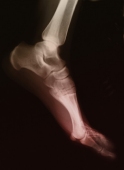
WEDNESDAY, April 28 (HealthDay News) — Stanford researchers have found a way to significantly speed up the healing of broken bones in mice, a feat which, if replicated in humans, could mean people with fractures would be free of their casts a lot sooner.
“This has huge implications,” said Dr. Victor Khabie, co-director of the Orthopedic and Spine Institute at Northern Westchester Hospital in Mt. Kisco, N.Y. “Broken bones is a big problem, and this is just the tip of the iceberg.”
The technique could help in fusing bones as well, and many other surgeries that rely on bone growth and bone healing to succeed, he added.
“A lot of the surgeries we do rely on bone growth and bone healing, and a lot of the failures of surgery have to do with the fact that the bone never heals or the fusion never [takes],” Khabie explained.
And this might have applications beyond bones.
“It isn’t limited to bone injuries,” said Dr. Jill Helms, senior author of the study published in the April 28 issue of Science Translational Medicine. “There’s a lot of interest in the role that [the protein used in these experiments] plays in tissue repair and tissue regeneration.”
That also includes blood, neural and cardiac cells, added Helms, who is a professor of surgery and of plastic and reconstructive surgery at Stanford University School of Medicine.
The research borrowed a chapter from the lives of animals that can regenerate on their own, such as zebrafish and flat worms.
Scientists already knew that this capability was partly due to a class of proteins called Wnt proteins.
Although mammals don’t have the same innate ability to regenerate, the researchers speculated that, with a little help from Wnt proteins, maybe they could.
The researchers actually conducted two experiments, both testing the idea that tissues might heal faster if the Wnt signal was ramped up.
The first used a genetic approach, involving mice that had been genetically engineered to respond better to a Wnt signal, then administering purified Wnt via fat particles known as liposomes.
The second strategy involved raising levels of the Wnt protein in normal mice. Both groups of mice had sustained bone injuries.
“Both experiments showed us the same thing, that when Wnt signals were prolonged in an injury site then healing was much more robust,” Helms reported. “When we delivered this form of the protein in a little lipid [fat] particle to an injury site, we accelerated the healing quite dramatically.”
In fact, within the first three days, those mice had 3.5 times more new bone than the mice in the other groups, according to background information about the study.
Helms and her colleagues believe Wnt causes bone stem cells to divide more and turn into bone-forming cells much sooner.
J. Edward Puzas, a professor of orthopedics and senior associate dean for basic research at the University of Rochester Medical Center, added that the idea might also benefit people who sustain potentially life-threatening fractures as a result of osteoporosis.
In separate ongoing studies, Puzas is finding that the osteoporosis drug Forteo is also useful in healing bones.
The Stanford group is now expanding its work to speed tissue regeneration after skin wounds, heart attacks and stroke.
More information
The American Academy of Orthopaedic Surgeons has more on bone fractures.

